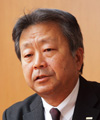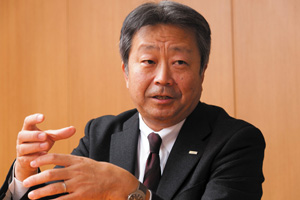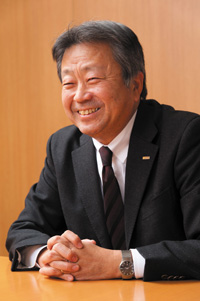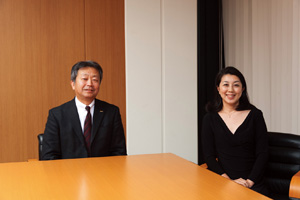 |
|
|
|
|
|
View from the Top Vol. 10, No. 3, pp. 1–4, Mar. 2012. https://doi.org/10.53829/ntr201203tp1  Becoming a Leading Player through Globally Seamless ServicesOverviewIn 2011, NTT Communications announced its Vision 2015 growth strategy and reorganized its corporate structure by function. NTT Communications has set a goal of becoming a leading player in a market dominated by globalization, the cloud, and smartphones. We asked Executive Vice President Jun Sawada how the company can increase market share in such a dynamic, worldwide market. Leveraging group power on the basis of a common principle of connecting—Mr. Sawada, please tell us about the Vision 2015 growth strategy. When this vision was drawn up in 2011, global markets, the cloud, and smartphone services were already at the center of the business environment. And after three consecutive years of decreasing sales and profit and with competitors who were actually growing, we felt the need for a strategy that could address these circumstances. The Vision 2015 slogan is “Global ICT Partner—Innovative. Reliable. Seamless.” (ICT: information and communications technology). Our goals here are to strengthen further our existing competencies in Asia, become an optimal partner for our customers throughout the world who wish to expand into fast-growing markets in Asia and emerging nations, and become highly regarded by all our customers as a bona fide leading global player on the same level as the four current major players (AT&T, Verizon, BT, and Orange) by 2015. Awareness of the NTT brand was surveyed about a year ago, but unfortunately, the results indicated a level that could hardly be called high. NTT Communications does business in 30 countries from 78 base offices, and my aim is to raise awareness of the company and to become a leading player in both name and reality. I also want the company to expand its business on the basis of our shared value of bridging networks. To give you some specific targets, I would like to raise the group’s consolidated revenue to at least 1.5 trillion yen by doubling the sales of our global businesses. Furthermore, with an eye to increasing the percentage of our business in new fields to 80% and beyond, I want the whole NTT Communications group to move forward with great speed, develop best practices, and increase group power overall. Overhauling the organization with success in mind—What is your specific strategy for achieving these objectives? To achieve these objectives, we need to improve our competitive power. This also holds true for our objective of raising worldwide awareness of NTT Communications: if we are losing out to our competitors, we can’t expect to make much progress in establishing awareness. This is the era in which customer needs and wants move seamlessly from one location to another. It simply doesn’t work to have, say, one service structure for Japan and another for the USA. Although some customization may be needed for each region, a company must be able to provide the same quality of service based on the same standards throughout the world. Most people would agree that success, for a company, means profit and name recognition. But these factors depend on being selected by a customer. To maintain growth, we would like to be selected by companies desiring to expand overseas and even by our overseas customers seeking growth under these severe global economic conditions. By pursuing such business, I would like to see NTT Communications grow together with our customers. But there’s more. To get our customers to select us for their business plans, we must take the initiative and face our problems directly with a determined attitude. To this end, we undertook a major restructuring—the first since the founding of NTT Communications—based on three main pillars: a service-oriented approach, globally seamless operations, and a function-based structure. As part of this restructuring, we transformed our approach to services. In the past, we focused on individual user needs and developed new services from the viewpoint of the service-receiving side. From here on, there will be a greater emphasis on presenting services from the service-provisioning side. Specifically, we began by restructuring the corporate organization according to three core functions—sales, services, and operations—and staff. That is, we established a system that would give us a competitive edge by consolidating and optimizing by function all of the resources and know-how distributed throughout the organization so that they could be used in the most effective way possible. Although it will take time for substantial results from this approach to be seen, some effects have already begun to appear as a wide array of similar services come to be consolidated into larger services through organizational restructuring. As these objectives become established and we work to achieve them, it is important that all those concerned throughout the world understand the essentials of this effort and move together with one mind. We are making progress in establishing a common vision, but I want to make sure that we involve our more than twenty overseas subsidiaries in moving forward. Company rules have also been changed to a considerable extent, but not to the point of causing major confusion. At the same time, a situation with no confusion at all would seem to mean that no reform has actually taken place, which is something that I would worry about! Actually, out of 100 problems that we extracted from opinions gathered at all NTT Communications sites, 34 of them concerned organization. We are working to solve those problems in a step-by-step manner. The other problems involved requests and issues concerning processes and methodologies. All of these problems should be solvable as long as we face them head on by disseminating the right information and promoting understanding. It is difficult to create a perfect organization first time around. The role of business is to respond to ongoing changes in society, and as a result, the situation surrounding us at NTT Communications is always changing. We will keep a close watch on this changing situation and respond appropriately to it without destroying our three business pillars of a service-oriented approach, globally seamless operations, and a function-based structure. A failure to change with the times can only lead to confusion in the workplace.
Rejecting a niche role for growth as a global player—NTT Communications has formulated a Global Cloud Vision as one example of globally seamless operations—one of the company’s three main pillars. Could you tell us a bit about it? Our Global Cloud Vision aims to provide a wide range of services reflecting our company’s strengths—from networks and datacenters to servers and applications—in an end-to-end, one-stop manner. In short, we are rolling out a cloud service that we would be expected to provide as a communications operator but in a globally seamless manner. The key technology here is open source software such as OpenFlow, which enables centralized path control on the network, and OpenStack, a cloud controller. The Global Cloud Vision aims to provide multivendor support to gain a competitive edge, that is, to support equipment and operating systems from multiple vendors that customers are introducing into their systems, and it is moving quickly to establish an open-source base in virtualization technology. By the way, this cloud service deploys research achievements of the NTT Information Sharing Platform Laboratories. I believe that NTT Communications was the first in the world to announce the commercialization of a virtualized network connecting datacenters using OpenFlow technology in the form of a cloud service. We also plan to incorporate extensive security measures in this service in response to the growing worldwide demand for more secure remote access. Unfortunately, though, NTT Communications currently lacks the might to take on local services in regions throughout the world. This is exactly why we would end up being just a quick niche player if we didn’t make tight connections. If we truly desire to take our place next to entrenched operators in other countries as a global player by 2015, we must increase our presence. We are also making steady progress in terms of infrastructure. One example is an undersea cable called the Asia Submarine-cable Express (ASE). This cable planned by NTT Communications is scheduled to interconnect Japan, the Philippines, Hong Kong, Singapore, and Malaysia. Since the seabed of the Bashi Channel south of Taiwan is unstable owing to frequent earthquakes, we are routing this cable as close to the Philippines as possible, but it will still be able to connect Japan with these countries in the shortest, fastest way. The cable will be linked with the Pacific Crossing cable that we purchased two years ago. And we will provide a highly reliable international network service via the world’s fastest cable connecting the west coast of the USA with Japan, Hong Kong, and Singapore.
Moving forward with speed and a zeal for reform—After undergoing such a large-scale restructuring, what does NTT Communications resolve to do this year? Our business standards for Japan have already been set, and from here on, we will be creating standards that will work for us on the global scene. What is important for each and every one of us at NTT Communications is reform and speed. With a sense of resolve that seeks to throw out the old, we must face the future head-on. If we were to bring Japanese standards with us into the world, they would not necessarily be considered useful or appropriate by our global colleagues. Instead, on the basis of a global, common perspective, we should treat Japan as a local market that needs our support. Of course, I myself have to change! Just putting my thoughts on paper does not bring about any changes. And even if I attempt to instigate reform together with my Japanese colleagues and international ones as well, that doesn’t mean that we will automatically be on the same wavelength. Executive management—myself included—and middle managers must develop a good understanding of the situation that we are in and make constructive comments and hold discussions. The technology and services that can now be provided already exceed my imagination. The fact is, obsolescence is rampant in our industry. I’m sure that all of us sense just how transient technology, services, and customer attitudes and range of experience can be. The essence of our business, however, must not be blurred. There is nothing to worry about as long as we have a clear understanding of what is essential in our endeavors. What we must be faithful to here is what our worldwide customers, including our Japanese customers, want. Looking forward, we will strive to provide services in a highly motivated, faithful manner. We may be suffering now, but I firmly believe that tomorrow will be a better day. Let’s run together into the future!
Interviewee profileCareer highlightsJun Sawada entered Nippon Telegraph and Telephone Public Corporation (now NTT) in 1978. After serving as manager of various network facilities, he moved to the business planning section in the Corporate Planning Department in 1988. He was involved in the reorganization of NTT in 1996 as a member of the restructuring office. Then, after working in international services and serving in the USA, he was instrumental in developing and launching new businesses from the NTT Communications Corporate Planning Department in 2000. He became general manager of the Kansai branch office in 2003, vice president of the Corporate Planning Department in 2006, and senior vice-president in 2008. He took up his present position in 2011. |
|










